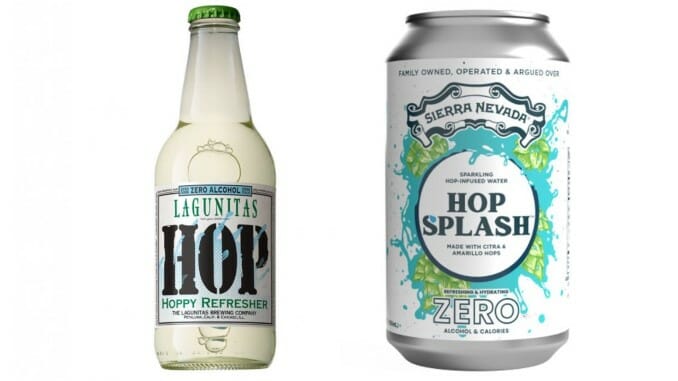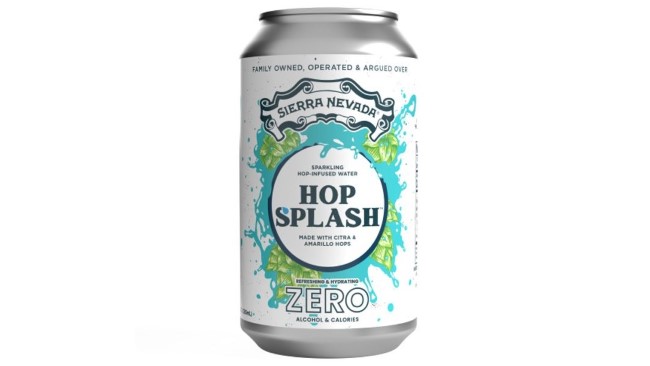Tasting: Lagunitas vs. Sierra Nevada Hop Waters
Photos via Lagunitas, Sierra Nevada
I’ve written quite a bit about non-alcoholic beer and spirits in the recent past, and it’s of course a topic that becomes especially relevant every Dry January, but one of the realities of this corner of the booze world is that each product you try has a tendency to subtly redefine your idea of what “NA beverages” really means. A traditional non-alcoholic beer, after all, is exactly what it sounds like—a standard beer that has been brewed to completion, and then had its alcohol removed. What, though, does that really make the “hop water” trend of recent years, in which breweries infuse carbonated water/seltzer with fresh hop flavors? There’s no malt, sure, but modern IPA has already become a category where malt flavors are practically nonexistent in most of the popular hazy examples. If both an NA IPA and a hop water are non-alcoholic, and both are primarily focused on delivering unimpeded hop flavors, then one might actually argue that it’s the hop water that is more cleanly serving the purpose of delivering an IPA experience without the alcohol.
With that said, hop water has largely been a small novelty in the market in recent years, an experiment of small breweries that hasn’t found a lot of wide distribution. The one prominent exception would be Lagunitas Brewing Co.’s Hoppy Refresher, a glass bottled product sold in 4-packs, which has been around for several years, effectively laying groundwork for the style as a bigger commercial category. With the arrival of another brand from a major brewery, though—Sierra Nevada’s new Hop Splash—the market now has several prominent hop water brands with the backing of recognizable craft beer brands. Likewise, the choice of Sierra Nevada to sell its hop water in 12 packs of cans suggests they believe that hop water is ready for a significantly bigger audience.
I happened to have samples of both in my home, so I figured a head-to-head tasting was in order. How do these two compare, given that they’re likely to be category leaders? And how does the experience of drinking these compare to an IPA, alcoholic or non-alcoholic? Let’s see.
Lagunitas Hoppy Refresher
Likely the most recognizable and widespread “hop water” product on the market today, Lagunitas Hoppy Refresher only seems to be sold in 4-packs of 12 oz, clear glass bottles, at a price point of around $6-7 in most places. Ultimately, this puts both of these hop waters in a similar price bracket as the beers they would likely be replacing, although perhaps a bit more affordable overall. One wishes that the category might be as affordable as La Croix-style supermarket flavored seltzers, given that one of the biggest sticking points for some consumers with non-alcoholic beer is that they inherently feel it should be less expensive than standard beer. Unfortunately, this isn’t feasible for NA beer, which is simply normal beer (and normal expense) with the alcohol removed, but it would be nice if the “hop water” segment could differentiate itself on the price front. The $10 average for a 6-pack of Sierra Nevada’s Hop Splash, meanwhile, is pretty comparable to what we might call “high value,” flagship craft IPAs. As for Lagunitas, one has to wonder if they’ve considered transitioning this into larger packs, or cans, in order to confer more value. As is, the 4-packs of bottles has a certain “craft soda” feel to it. And once you taste this stuff, that comparison feels particularly apt.
On the nose, Hoppy Refresher is actually rather dramatic, and more vivacious than one might expect. It smells quite sweet, with big fruity and resinous notes right up front. It’s reminiscent of pelletized green hops (homebrewers will understand), combined with a handful of tropical gummy candies. It’s surprising how fruity this is, and how sweet the nose reads.
The same is true on the palate, which is awash in big fruit flavors of pineapple and passion fruit and various gummy notes like Welch’s Fruit Snacks. There’s some greener and more resinous qualities of course, but the tropical fruit really carries it. It also seems genuinely sweet on the palate despite being zero calorie, which makes me wonder what other kind of chemical magic might be at play here—Lagunitas mentions using “Sulphur compounds” among other things to achieve the desired flavor profile. Overall, the effect evokes some kind of tropical fruit soda—a profile that seems a tad artificial at times, but satisfying all the same. One’s opinion of this stuff has a tendency to change from sip to sip, but it seems like one that is very much calculated for mass appeal.
Sierra Nevada Hop Splash
Before tasting these head to head, I wondered if they might end up being so similar that I’d be grasping at straws, but the opposite mainly proves to be true. Although the marketing materials for Sierra Nevada Hop Splash understandably talk up crowd-friendly descriptors like fruitiness, this product is significantly more restrained and “pure” in its hoppiness compared to the Lagunitas Hoppy Refresher, with more breadth of hop character but less punchy fruitiness.
On the nose, Hop Splash is somewhat milder than the bombast of the Lagunitas, with notes that are more floral, fresh and herbal in comparison. There’s a slightly mustiness and spicier buzz that reminds me of an older generation of hops—this product is reportedly made with Citra and Amarillo, but I’d say it’s the latter that is lending significantly more of its character. I don’t think anyone would be smelling this and immediately thinking “tropical fruit juice.”
On the palate, this is likewise definitely more spicy and herbal in comparison with the Lagunitas Hoppy Refresher. There’s grassy notes, and resin, some drier citrus and something almost slightly peppery. Hop Splash likewise does not have that same impression of sweetness that was so unexpected in the Hoppy Refresher—this perhaps tastes more like one might expect “hop water” to taste, whereas the Hoppy Refresher channels more of the sweetness that is expected in modern hazy IPA. Of course, it’s entirely possible that the Hop Splash might seem more fruit forward in a vacuum, or that Sierra Nevada as a company is just more likely to take a measured approach to its flavors, in comparison with Lagunitas. But where Lagunitas carpet bombs with fruit flavors, Sierra is more subtle.
As for which of those profiles is superior, it really comes down to taste. Those who are craving the fruitier, juicier aspect of modern IPA in a seltzer form will likely be drawn to Lagunitas Hoppy Refresher, which has those qualities in spades. And those who are more into the older style of IPA may well think that Hop Splash is the better of the two, or at least the one with the more “grown up” profile.
Regardless, I can genuinely see either of these standing in for non-alcoholic IPA, given that they provide the thing that modern IPA largely exists to convey: Pure hop flavors. Of course, if they wanted to find a way to lower prices a bit, that would be fine too.
Jim Vorel is a Paste staff writer and resident beer and liquor geek. You can follow him on Twitter for more drink writing.

